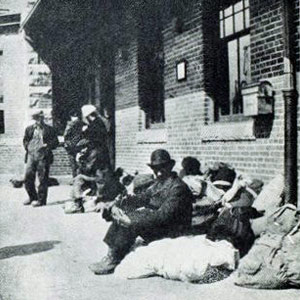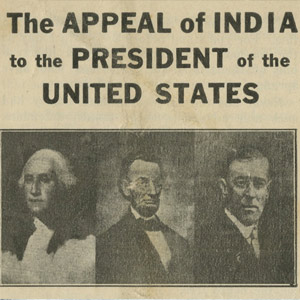Anti-Immigrant Sentiments 100 Years Ago and Now

(Indian-American Chronicles)
(Left) Photo titled 'Hindus at Bellingham, Washington, awaiting the train for Vancouver, B.C., after the race riot.' From The Foreign Invasion of the Northwest, (1908).
Throughout its history, America—this land of immigrants—has often turned against certain of its immigrant communities. The Japanese internment camps during World War II, from one chapter of our history, and the modern-day anti-Mexican sentiments whipped up by President Trump come to mind. When it comes to Indians being the target of such anti-immigration fervor, there was perhaps none worse than the Immigration Act of 1917.
This past February marked the one hundred year anniversary of the Immigration Act of 1917. When it was passed, the 1917 Act constituted the most sweeping immigration law in U.S. history. In addition to a number of restrictions, the 1917 Act excluded from the United States all peoples living within a certain geographic area referred to as the “Barred Zone,” which included almost all of Asia except Japan and the Philippines.
Because Chinese and Japanese laborers were already excluded from the United States, and Filipinos were U.S. “nationals” as a consequence of American colonization of the Philippines, the “Barred Zone” Act was intended to prohibit the entry of migrants specifically from South Asia and mainly from British India.
U.S. immigration officials, labor leaders, and Congressional representatives had been trying to prohibit Indians from entering the country for years. Public agitation against the entry of Indian migrants grew to a fevered pitch in the late summer of 1907, when nearly 200 Indian workers were forcibly driven out of Bellingham, Washington, at the hands of an angry mob.
In their exclusionary campaigns to exclude Indians, white workers across the Pacific Coast linked their struggles to those of their white working-class counterparts in Canada, South Africa, and Australia. In other words, they saw themselves as part of a broader effort to protect and enforce what were then commonly referred to as “white men’s countries” by demanding the passage of restrictive immigration laws against targeted nonwhite groups.
In the aftermath of the Bellingham riots, Indians began explicitly linking racial violence and discrimination in North America to colonial subjugation in India. A critical component of their anticolonial politics was the claim that their experiences as labor migrants in Canada and the United States were indicative of the convergence of colonial and racial oppression.
It was these kinds of anticolonial and antiracist articulations that caught the attention of U.S. officials. Immigration authorities and exclusionists pointed to the emergence of a number of Indian social and political organizations, periodicals, and anticolonial leaders based on the Pacific Coast to warn of the seditious nature of Indian migration and to demand more politically repressive laws and greater border enforcement.
During the spring of 1914, the U.S. House of Representatives Committee on Immigration and Naturalization held hearings on two bills aimed at imposing severe restrictions on the entry of Indian laborers. The hearings were initially framed around questions of the economic competition and labor “threats.” However, as the hearings went on, calls for Indian exclusion became indistinguishable from the Committee’s anxieties over Indian anticolonialism. Representative John Raker of California, a vocal advocate for Indian exclusion, insisted that Indians were making the country a “hotbed of revolution” by using it as a base to organize revolutionary political movements both domestically and abroad.
The Indian anticolonial movement that had been forged from the Pacific Coast was a heterogeneous and dynamic movement comprised of figures ranging from intellectuals like Taraknath Das, Har Dayal, and Lajpat Rai to migrant workers who formed the rank and file of the Ghadar Party. All of these activists focused on the twin goals of contesting British rule in India and challenging racial discrimination and racial violence in the United States. In the aftermath of the Bellingham riot, Indian migrants, students, and intellectuals began giving speeches and publishing periodicals from the United States that understood racism around the globe and colonialism in India in relation to one another.
British authorities later declared that the Ghadar movement in particular constituted the greatest threat to their rule in India during the First World War. As such, British authorities demanded that the U.S. crack down on Indian political activism. U.S. immigration, state, and justice department officials were receptive to British concerns and increasingly began to view Indian exclusion from the United States as working hand in hand with the repression of all revolutionary movements. Not surprisingly, in addition to the “Barred Zone” provision, the 1917 Immigration Act increased the statute of limitations for deportation from three to five years for any “alien” deemed to have subversive or dangerous political beliefs or associations—clearly targeting the anticolonial agenda of Indian immigrants.
Though anti-Asian racism was deeply embedded in American politics and culture at this time, calls for Indian exclusion were based not only on charges that Indians were incapable of assimilation and an economic threat to white workers but also that they were dangerous, subversive, and inherently “un-American.” While clearly enabled by xenophobic fears of economic competition, antiradical hysteria over Indian political activism also led to widespread support of the 1917 Immigration Act. These activists were also “stigmatized by the British as ‘plotters and seditionists.’” While Indian activists did call for an end to British colonialism and racial hierarchies, visions of emancipation that seemed dangerously radical to some, U.S. officials and exclusionists misrepresented a movement to contest imperialism and racism as a conspiracy against the U.S. government and a crime against society.

(Left) Booklet titled 'The Appeal of India to the President of the United States,' published by the Gadar Party. The booklet, dated 1917, contains letters to U.S. President Woodrow Wilson, and makes several analogies between U.S. history and the cause for Indian independence.
At the same time, economic and political migrants from India believed that the United States, a nation built upon the foundation of revolutionary struggle against the same empire that Indians sought to free themselves from, would provide a safe haven from which to organize their own freedom struggle. Indian political activists often likened themselves to American revolutionaries and asked Americans to recall “that the founders of this great republic ... accomplished exactly what we hope today for India.”
From 1917 to 2017
The rationale behind the Immigration Act of 1917 and the nativism, exclusionism, and surveillance that
it justified and reinforced are strikingly relevant today. Ultimately, the “Barred Zone” Act did not explicitly exclude Indians by identity, but on the basis of geography. In this regard, it is akin to President Donald Trump’s recent Executive Order 13769, “Protecting the Nation from Foreign Terrorist Entry into the United States,” or the so-called Muslim ban. In addition to initially excluding migrants from seven predominantly Muslim countries, the order calls for the “extreme vetting” of all refugees seeking admission and for enhanced standards to scrutinize all persons seeking admission to the country. Much of the rhetoric behind this Executive Order is reminiscent of the 1917 Immigration Act,
particularly in its appeals to national security.
Recent events, from Executive Order 13769 to the shootings of South Asians from Kent, Washington to Olathe, Kansas, have demonstrated that the anti-immigrant sentiment and nativist demands for exclusion that led to the passage of the 1917 Immigration Act have not been relegated to the past but, indeed, continue to resurface in our own time. It may seem that the country has made great progress since the passage of the Immigration Act of 1917 and in some ways it has, as demonstrated by the legal challenges that the Executive Order has faced in numerous courts on the basis of its discriminatory intent. Nonetheless, the recent Executive Order is a reminder that our immigration policies are often the sites through which appeals to fear and hysteria in the name of national security can be exploited and, if left unchallenged, used to justify racial discrimination, violence, and exclusion.
Seema Sohi is an Associate Professor in the Department of Ethnic Studies at the University of Colorado, Boulder. A version of this article first appeared in SAADA. (https://www.saadigitalarchive.org/)
Enjoyed reading Khabar magazine? Subscribe to Khabar and get a full digital copy of this Indian-American community magazine.
blog comments powered by Disqus












